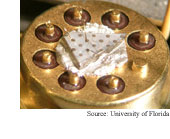|
NEWS
|
Invisibility,
in theory
A pair of theoretical studies (1,
2)
show how to design invisibility cloaks -- materials that
bend electromagnetic waves like light and radio waves
around objects. The technology, which awaits the development
of viable materials, has obvious applications for law
enforcement and the military. (Controlling Electromagnetic
Fields and Optical Conformal Mapping, Science, Published
Online May 25, 2006)
Ubiquitous hydrogen sensors
 A
key ingredient of the hydrogen economy is a tiny, inexpensive,
maintenance-free sensor that detects and tracks leaks
of the colorless and odorless but potentially explosive
gas. A prototype
combines a nanowire-based hydrogen detector, wireless
data transmitter, solar cell and piezoelectric generator
to produce a sensor that powers itself from sunlight and
vibrations. (Low-Power Detection of Hydrogen Leakage Using
a Self-Powered Wireless Hydrogen Sensor Node, American
Institute of Chemical Engineers (AIChE) 2006 Spring National
Meeting, Orlando, Florida, April 23-27, 2006) A
key ingredient of the hydrogen economy is a tiny, inexpensive,
maintenance-free sensor that detects and tracks leaks
of the colorless and odorless but potentially explosive
gas. A prototype
combines a nanowire-based hydrogen detector, wireless
data transmitter, solar cell and piezoelectric generator
to produce a sensor that powers itself from sunlight and
vibrations. (Low-Power Detection of Hydrogen Leakage Using
a Self-Powered Wireless Hydrogen Sensor Node, American
Institute of Chemical Engineers (AIChE) 2006 Spring National
Meeting, Orlando, Florida, April 23-27, 2006)
Cellphone as chemical sensor
A way to use computer
screens to detect chemicals could turn any cellphone,
handheld or computer into a chemical sensor or medical
diagnostic tool. The system uses a camera to record the
colors of light from a computer screen shone through a
transparent film of molecules that change color in the
presence of specific chemicals. (Chemical Sensing with
Familiar Devices, Angewandte Chemie International Edition,
June 2, 2006)
Ultraviolet LEDs
A light-emitting diode made of aluminum nitride
produces ultraviolet light. The ultraviolet
LED provides an alternative to bulky and expensive
ultraviolet lasers for chipmaking, high-capacity optical
data storage, airborne particle detectors, and water and
air purifiers. (An Aluminium Nitride Light-Emitting Diode
with a Wavelength of 210 Nanometres, Nature, May 18, 2006)
Speedy nanowire transistors
A study shows that transistors
made from nanowires with germanium cores and silicon
shells performed three to four times better than state-of-the-art
field-effect transistors. Nanowire transistors could lead
to a new generation of compact, high-speed computer circuitry.
(Ge/Si Nanowire Heterostructures As High-Performance Field-Effect
Transistors, Nature, May 25, 2006)
Stability for fusion experiments
Fusion -- the process that powers the sun -- promises
unlimited, clean energy, but fusion reactors that produce
more energy than they consume have eluded scientists for
several decades. One challenge is containing the super-hot
plasma produced by the reaction, which damages everything
in its path, including the reactors. Introducing
a little chaos into the magnetic field that contains
the high-temperature plasma in fusion reactors cuts down
on reactor damage. (Edge Stability and Transport Control
Resonant Magnetic Perturbations in Collisionless Tokamak
Plasmas, Nature Physics, published online May 21, 2006) |
FEATURES
|
View
from the High Ground: ICL's John Pendry
Physics as machine tool, negative refractive
index, metamaterials, shattered wine glasses, higher capacity
DVDs, scientific backwaters, risk perception and practice,
practice, practice.
|
How
It Works: Quantum computing: qubits
Photons, electrons and atoms, oh my! These particles are
the raw materials for qubits, the basic building blocks
of quantum computers. |
|
 |
News RSS feed 
Blog RSS feed 
Bookshelf RSS feed

New: TRN's
Internet Services
TRN's Jobs Center
|
| |
|
| |
|
| |
"Physics
is to the rest of science what machine tools are
to engineering. A corollary is that science places
power in our hands which can be used for good or
ill. Technology has been abused in this way throughout
the ages from gunpowder to atomic bombs."
- John Pendry, Imperial College London |
|
| |
|
| |
Thanks
to Kevin from
GoldBamboo.com
for technical support |
|

